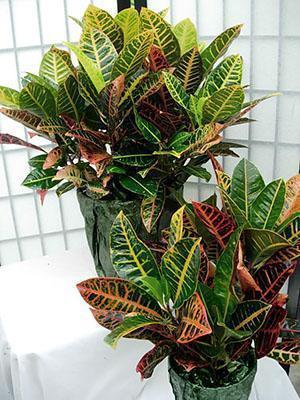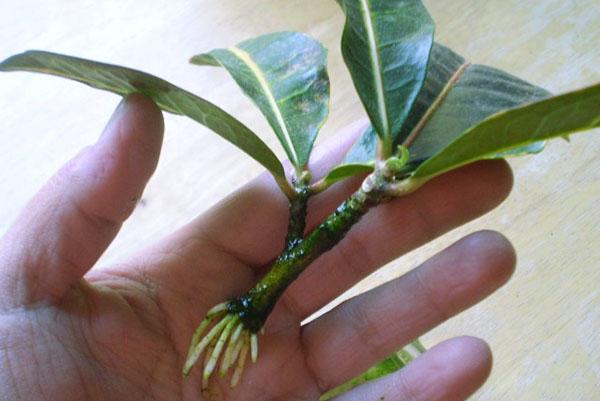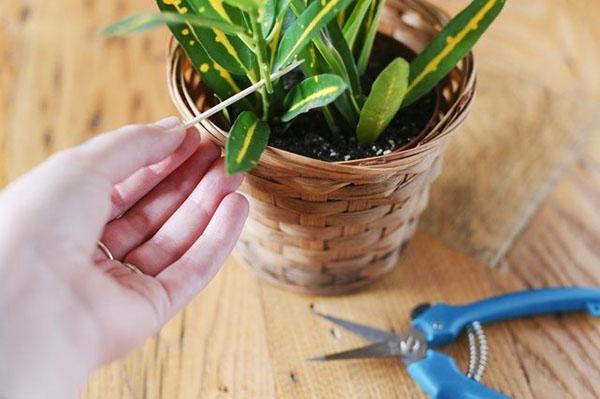Reproduction of croton at home
 Spectacular crotons are not considered the easiest to keep, but with proper attention and patience, the plant responds to care with good growth and healthy variegated foliage.
Spectacular crotons are not considered the easiest to keep, but with proper attention and patience, the plant responds to care with good growth and healthy variegated foliage.
And if you wish, you can also get a new croton, the reproduction of which at home is carried out in three main ways:
- using cuttings;
- sowing independently obtained or purchased seeds;
- by means of air layers.
How to propagate croton at home? What pitfalls can a florist meet, and which of the methods is the most affordable?
Croton propagation by cuttings

If you take only a leaf for reproduction, then it will give powerful roots, but you can not wait for further development. Without a bud from which the shoot would begin to grow, it will not work to get a young copy of an ornamental plant.
 The best time for cutting cuttings is early spring, when the shoots have not begun to actively grow:
The best time for cutting cuttings is early spring, when the shoots have not begun to actively grow:
- When cutting an apical cutting, its length should be within 6–10 cm. In this case, the future plant will form a good root system and form a small, strong stem.
- Stem cuttings are cut by straight cut so as to obtain one internode with an adult leaf and bud.
To ensure that the cuttings take root and subsequently go into growth, it is better to cut them from lignified healthy shoots.
 Both experienced and novice florists often have questions about croton breeding, a photo and a step-by-step description of all stages will help prevent mistakes and soon enjoy new green pets:
Both experienced and novice florists often have questions about croton breeding, a photo and a step-by-step description of all stages will help prevent mistakes and soon enjoy new green pets:
- Milky sap is always secreted at the cut sites. It should be lightly dried with a napkin or washed off.
- Large leaves on the tip of the shoots, which can weaken the cutting, taking away nutrients from it, are cut by half.
- The lower leaves that interfere with rooting are removed.
- Then the cuttings used to propagate croton are kept in air for a couple of hours.
- And only after such preparation, the planting material is immersed in warm water for several centimeters.
 But the correct preparation of the seedlings is not enough. When croton is propagated by cuttings, it is important that the rooting water temperature is between 24-30 ° C. In this case, it is useful to use the available root formation stimulants:
But the correct preparation of the seedlings is not enough. When croton is propagated by cuttings, it is important that the rooting water temperature is between 24-30 ° C. In this case, it is useful to use the available root formation stimulants:
- if the liquid cools for a long time, root formation first slows down, then stops, and the seedling rots and dies;
- in warmer water, the roots also grow reluctantly, and there is a high risk of developing bacterial flora.
All the time, from getting into the water to planting in the ground, the seedlings should be in the bright, but diffused sun, in conditions of long daylight hours.
 When roots appear on the cuttings, with the help of which croton propagation is carried out, you should not expect their significant elongation. It is much easier to transfer seedlings with a root system about 2–3 cm long into the ground. The roots are not damaged during planting, and the crotons themselves start growing faster.
When roots appear on the cuttings, with the help of which croton propagation is carried out, you should not expect their significant elongation. It is much easier to transfer seedlings with a root system about 2–3 cm long into the ground. The roots are not damaged during planting, and the crotons themselves start growing faster.
With a properly selected soil composition and high air humidity, Croton successfully acclimatizes and takes root at normal room temperature in a couple of weeks.
Croton propagation by air layers
 If an adult croton grows in an apartment with a lignified, leafless trunk, then air layers can be obtained on such a plant. How does croton reproduce in this interesting, but rather painstaking way?
If an adult croton grows in an apartment with a lignified, leafless trunk, then air layers can be obtained on such a plant. How does croton reproduce in this interesting, but rather painstaking way?
To obtain planting material, a strong shoot is chosen. You can also use the top of an adult plant. At a distance of 10-15 cm from the end of the stem, the bark is cut in a circle so as to expose about a centimeter of wood. Here croton, when propagated by air layers, should form roots.
 Cutting point:
Cutting point:
- carefully treated with a growth enhancer;
- wrapped in a layer of sphagnum moss;
- cover with a bag, which is securely fixed under and above the bare area.
The moss is pre-moistened, and provides for the possibility of watering it in the future, until the air roots of the croton are formed. The root system should be expected to emerge from the surrounding moss in 4–6 weeks.
When this happens, the stem under the place of growth of the roots is cut off, and the resulting seedling, as in the propagation of croton by cuttings, is transplanted into the ground. Caring for a plant is also no different from the method already described above.
Seed propagation of croton at home
 Croton propagation by seeds is the most laborious and time consuming way to get a new plant. If a florist decides to conduct such a bold experiment, for example, wishing to grow a hybrid or rare specimen, he should remember that indoor croton seeds:
Croton propagation by seeds is the most laborious and time consuming way to get a new plant. If a florist decides to conduct such a bold experiment, for example, wishing to grow a hybrid or rare specimen, he should remember that indoor croton seeds:
- do not pass parent properties;
- in a short time after ripening, they lose their germination;
- before sowing, decontamination and special preparation are required to accelerate germination.
Even after waiting for the shoots, you will have to pay a lot of attention to them, since the seedlings are often weak and develop very slowly. Only experienced indoor crop lovers can recommend this croton breeding method at home.
For disinfection, croton seeds are first immersed in hot water for half an hour, and then soaked in water at room temperature for another day. A growth activator can be added to the liquid.
After preparation, sufficiently large seeds are gently pressed into a loose, necessarily sterilized substrate to a depth of 1 cm. The soil surface is moistened, and the container with crops is placed in a greenhouse. At high humidity and temperatures between 22 and 25 ° C, the seeds will germinate in about a month. When shoots appear, they continue to be carefully watered and gradually accustomed to indoor air, more and more often they open the greenhouse. Crotons with three open leaves can be transplanted into separate pots.
If there are no cuttings, you can propagate with leaves. You just stick it into the ground, water it, put it in a bag, tie it up. Put in the shade. In the process of root formation, water occasionally and sprinkle. I so propagated the Croton of the excellence variety in October. In February, there were already roots.